The 9 Best Drum Mic Kits for Recording Drums at Home
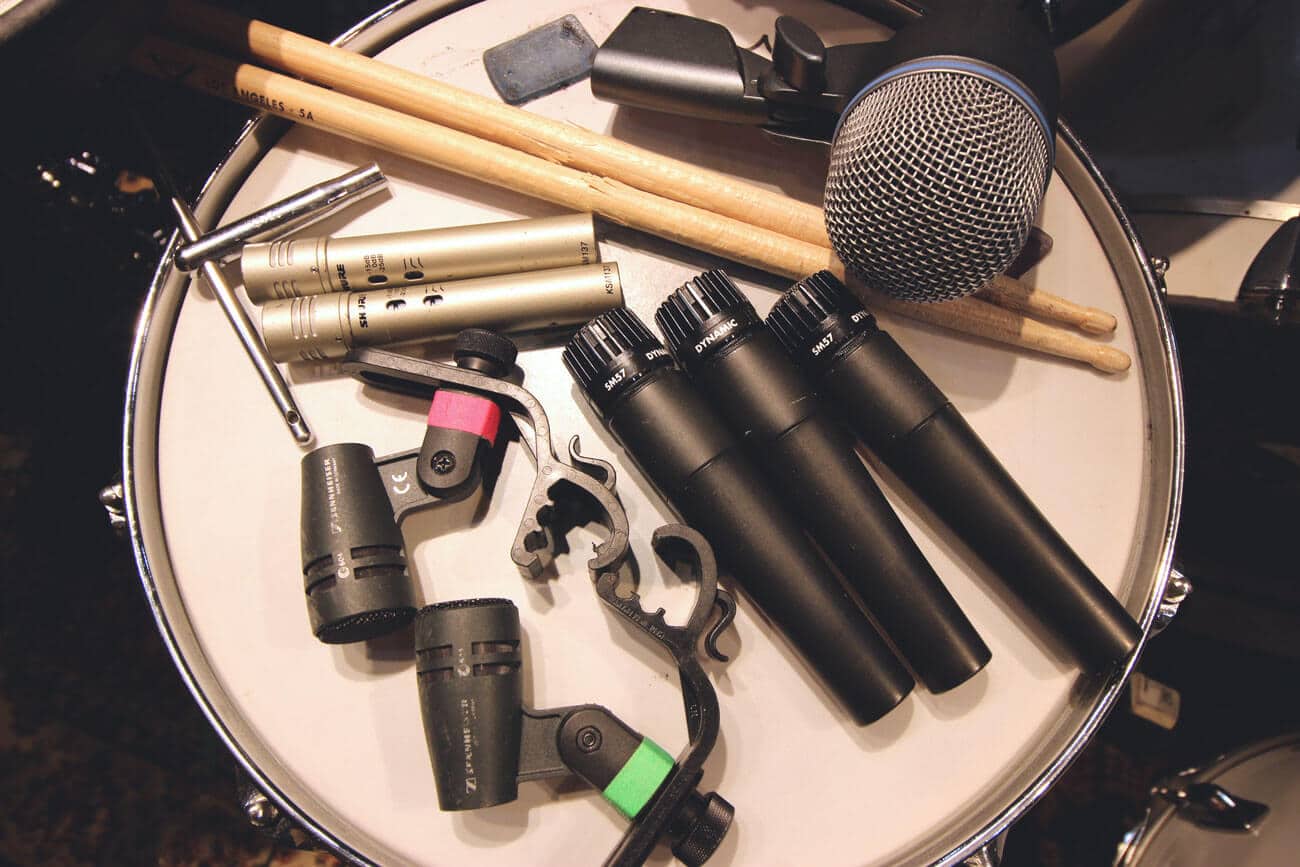

Are you looking for the best drum mic kit to capture your performance? Well, look no further, as I’ve got the best guide on choosing drum microphones for both beginners to recording and seasoned vets.
Chances are you’re a bit confused and lost with what you’ll absolutely need. You’re not alone. There are tons of drummers out there who want to learn how to record their own band, shoot YouTube videos, and even bring microphones with them for live performances.
While you can purchase drum microphones individually, buying a drum mic kit offers a simple solution with a bundled monetary benefit. Drum mic kits vary in quality and size. I have done my best to pick the best-performing products while staying reasonable with a budget.
While there always will be the most expensive option, I’ve kept that for last. All microphone manufacturers I list here make quality products that I personally use or have used. It may be difficult to narrow down which kit will work best for you, but I have taken most of the hard work out for you.
For the best result, I recommend the Earthworks DK7 drum mic kit. You get everything you need to record a three-tom drum set. And the microphones do not disappoint. They’re extremely transparent and can handle super high volumes. They’re a bit on the pricier side, albeit, but the DK7 is worth every penny.
So, with the quick table out of the way, let’s have a more in-depth look at some of these microphone kits for recording drums.
1) Earthworks DX7
Earthworks DK7 Drum Kit System
7-Microphone DrumKit
If you’re looking for an amazing drum mic kit, look no further than the Earthworks DX7. This kit has been endorsed by Adam Tuminaro, the Orlando Drummer, himself. It’s everything you need to mic a three-tom setup. Earthworks makes some of the best drum mics—I can attest from experience.
The overheads are smooth-sounding, and the tom/snare mics are condensers, meaning you’ll get a brighter sound than when using a dynamic microphone, like the Shure SM57. The kick drum mic also sounds fantastic—both bright and punchy, capturing the boom of the drum and the click attack of the bass drum beater.
The gooseneck design on the tom mics made it super easy for positioning the microphones on my tom drums. Compared to my Sennheiser e604s, these win tenfold, both in sound and usability (though they are more fragile). The DM20s are now my go-to tom microphones for live and creating content for Instagram and YouTube.
The microphones are housed in a roadworthy, high-impact case and they have an ultra-fast impulse response for killer-sounding drums. They capture sound with transparency and detail, making them perfect for live and studio recordings. So if you’re looking for the best of the best, the Earthworks DX7 is the kit for you.
2) Telefunken DC7 Drum Microphone Package
Telefunken DC7 Drum Microphone Package
7-Mic Drum Mic Package
Telefunken’s DC7 is a 7 piece drum mic kit—they offer the perfect way to get great sound out of your 5-piece drum set. The M82 gives you five different kick sounds to choose from, and the awesome mics for your snare drum and tom drums give you great sound without sacrificing quality.
The overheads with airy high frequencies give you the perfect way to add some spice to your sound, and the complete set of quality microphone cables ensures that you won’t have any problems getting the best possible sound out of your Telefunken DC7 Drum Microphone Package.
I don’t like how much space the DC7 mics take up when compared to other kits. The Earthworks mics have such a small profile and Sennheiser’s e604 mics are so ideal for live being so small and affordable. With that in mind, they do sound great, perfect for jazz drummers.
3) AKG Drum Set Premium 8-piece Microphone Set
AKG Drum Set Premium 8-piece Microphone Set
8-Mic Drum Mic Package
AKG’s 8-piece drum microphone set gives you amazingly detailed sound, whether you’re recording in the studio or performing live. The included D12 VR bass drum mic provides rich, deep bass, while a matched pair of C214 condensers captures every detail of your overheads.
The C451 B hi-hat microphone accurately reproduces the sound of your hi-hats, and four D40 instrument mics are perfect for toms and snare. The whole kit comes in a foam-lined aluminum carrying case for added protection. With AKG’s Drum Set Premium 8-piece drum mic kit, you’ll be able to capture the full dynamic range of your drums with incredible detail.
4) Heil Sound HDK-8 Drum Microphone Kit
Heil Sound HDK-8 Primo Dynamic Drum Cardioid Microphone Kit, 3x PR 28 Drum Mic
With the Heil HDK-8 Primo Dynamic Drum Cardioid Microphone Kit, you can capture the true essence of your drumming performance. This comprehensive microphone collection is designed for professional audio recording and live performances, offering unparalleled versatility and quality. The kit...
Heil Sound, a leading manufacturer of communications microphones, has been ranked with the leading manufacturers of communications microphones since 1982. The Heil Sound HDK-8 piece drum microphone kit is a culmination of over 2 years spent on the road with leading drummers, and gets you fully equipped to mic your drums right.
The Heil Sound HDK-8 Drum Microphone Kit includes: 1 – Heil PR-22 Kick Drum Mic, 1 – Heil PR-30 Tom Mic, 2 – Heil PR-31 Snare Mics, 4 – Heil PR-35 Overheads. The Heil Sound HDK-8 Drum Microphone Kit is the perfect way to get the full Heil experience. Order yours today and be ready to rock out tomorrow!
5) CAD Audio Stage7
CAD Audio Stage7 7 Piece Drum Mic Pack - Includes Kick Mic, Snare Mic, 3 Tom Mics and 2 Overhead...
Free shipping
Next up on this list is the most affordable: the CAD Audio Stage 7 piece drum mic kit.
This was the first drum mic kit I ever used when I started learning how to record drums and other instruments. The kit includes enough microphones to record a standard five-piece kit, including mics for the kick, snare, three toms, and stereo overheads.
If you’re looking to get some room ambiance in addition, you’ll have to grab a few more mics.
I can’t imagine using these mics today, but when I was just starting out, these were a perfect introductory set. They don’t sound amazing, but you cannot beat the price. Out of all the microphones in the kit, the most usable is the kick microphone.
The drum microphone kit includes stands, cables, and clips, so you won’t have to grab anything else accessory-wise.
6) Shure DMK57
Shure DMK57-52 Drum Microphone Kit
4-Mic Drum Mic Bundle
If there’s one drum mic kit out of this entire list that’s more important than all the others, it’s the DMK57. No other kit comes close to the versatility, flexibility, and longevity of these microphones.
You literally will use these the rest of your career. It’s almost a requirement to have a minimum of three SM57s in my book!
So yes, you’re only getting four microphones and will have to buy a separate pair of drum overheads, but these four microphones sound amazing and no one can deny the value of an SM57. Even without condenser overheads, you could use two SM57s as overheads and just use a snare and kick mic to get started (57s won’t sound necessarily bad on overheads).
These mics are ideal on snare drums, toms, guitar cabinets, and even hi-hat. The SM57 is an industry standard for a reason.
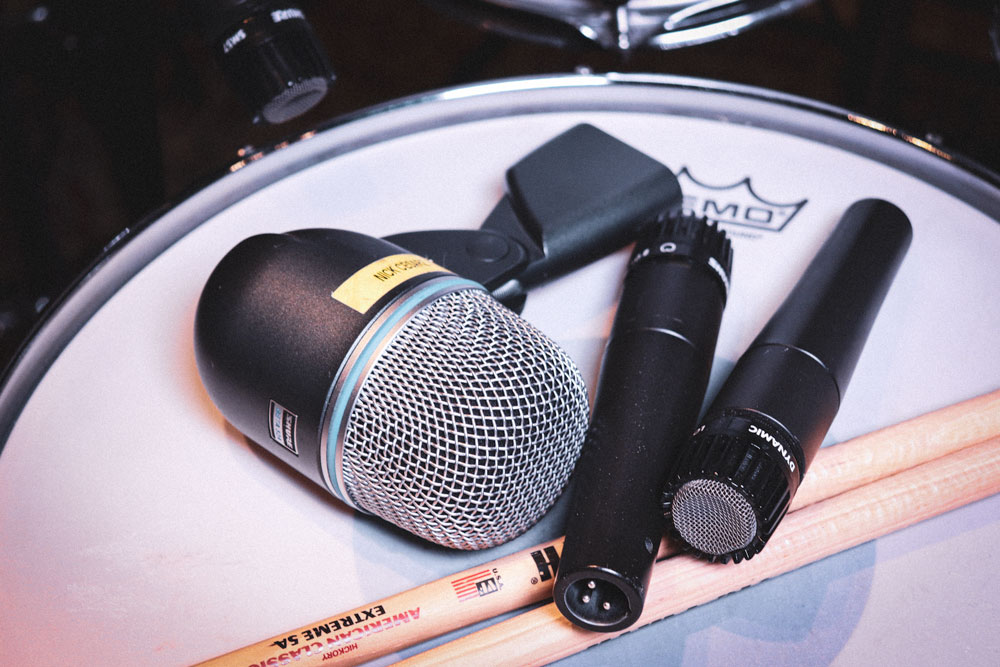
Now, I didn’t actually purchase the DMK57 myself, however, I did buy all the microphones included separately. Had I known how many 57s I’d be using, I would have gotten the kit.
7) Sennheiser Drum Kit 600
Sennheiser E 600 Drum Microphone Kit
When recording drums, you need a mix of microphones to capture professional results. Youll need clip mics that work well on snares and rack toms; a mic designed for low-frequency sources like the kick drum; and overhead mics to capture room sounds and natural reverb. . It is important that drum...
Sennheiser deserves so much more love than it truly gets, in my opinion. For live drum mics, it doesn’t get much better than these. Until you’re rocking the world playing arenas and touring by bus, this set of drum mics won’t let you down. They sound great!
The 7 piece drum mic kit includes:
- Sennheiser e602-II kick drum microphone (1)
- Sennheiser e604 tom/snare drum microphone (4x)
- Sennheiser e614 overhead microphones (2)
Why do so many sound engineers working in clubs or touring love e604s? They’re small, clip-on, and are super durable. They also sound great, which shouldn’t be a surprise.
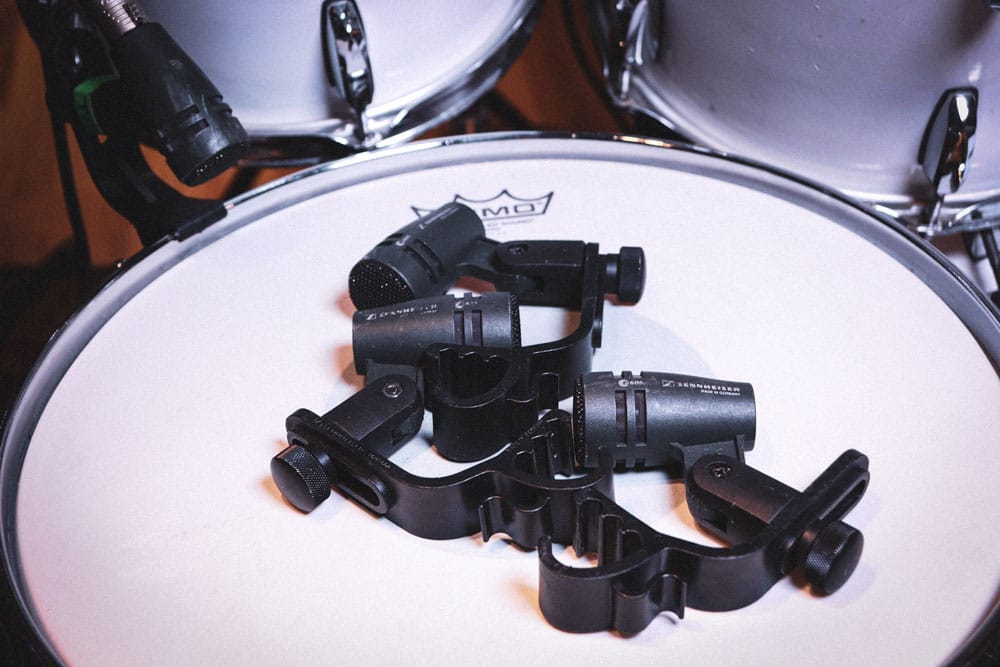
Personally, I wouldn’t recommend these for the studio, but if you needed to, they could still get the job done. With a little help from Slate Trigger2, you should have no problem using this kit for the studio and the stage.
8) Sabian Sound Kit
Sabian Sound Kit Drum Mic and Mixer Pack, Black, Regular (SSKIT)
I’ve been reading a lot about the Sabian Sound Kit on drumming forums lately. I have to say, I’m a little skeptical. First of all, a cymbal-maker is selling microphones and a mixer. It has to be cheap, right?
The Sabian Sound Kit is a three piece drum mic kit including a kick microphone and two overhead microphones. These then plug into the proprietary Sabian mixing board, which only has three XLR inputs, mind you. The microphones don’t sound terrible, but they don’t sound great either by any means.
The good
Sabian’s solution for drum recording is very simple. But that’s about it. I can’t come up with any other reason that you would want to pick up this kit. I suppose with this setup, you wouldn’t need to invest in an audio interface, so there’s that!
The bad
We all know that Sabian is foreign to the microphone and pro audio world. This may be a product intended to get beginning drummers a way to record their drum set, but I cannot endorse it by any means.
You can easily replicate this setup with used gear from your local shop for a fraction of the cost with much better microphones.
9) Audix Studio Elite 8
Audix Studio Elite 8 8-piece Drum Microphone Kit
8-Mic Drum Mic Studio Package
Audix is no small player in the microphone world. The Studio Elite 8 piece drum mic kit includes, as the name suggests, eight microphones to capture the sound of your kit.
The set of mics is a tad bit pricier than some of the others I’ve listed, but it’s extremely versatile. The pack includes the following mics:
- Audix D6 — a favorite for kick drums and even floor toms
- Audix i5 — excellent snare mic
- Audix D4 — a floor tom mic
- Audix D2 — good for rack toms
- Audix SCX25A (2) — for overheads
- Audix SCX1 — for hi-hats
A lot of engineers complain that the D6 is has too much pre-eq, leading to an already-processed sound, but I think the mic sounds incredible on kick drums.
If you need a more-natural sound, you may want to avoid the D6 on the kick. That said, for rock and metal mixes, it performs flawlessly. On the snare, the i5 works great, and compared to a SM57, it’s hard to decide which I like more.
The rim clips that attach the mics to your drums are fantastic — better than most I’ve seen from other manufactures.
Drum Mic Kits for the Home Recording Studio
If you plan on recording yourself at home for your band’s demos or YouTube videos, the microphone selection may be considerably different from a live setup.
The quality of the sound you get will be determined by several factors:
- The drums you’re recording
- Whether or not you have changed your heads
- The room you’re recording in
- The microphones you pick
- How good of a player you are
- How skilled you are as a sound engineer
- The audio interface and preamps used
Stepping up to the plate and recording music for the first time can be extremely daunting. Learning a digital audio workstation is a big undertaking. I suggest starting slow and watching some YouTube videos on the basics of recording drums to get a good foundation.
Required Gear to Begin Recording Drums
If you’re interested in recording drums at home, here’s the barebones essentials you’ll absolutely need to get recording.
- A drum kit – Come on. This one is obvious.
- A computer – PC or Mac is fine; whichever you prefer.
- An audio interface – This piece of gear converts analog signals from your mics, into a digital format your computer understands. I recommend getting an eight-channel interface.
- A digital audio workstation – I’m sure you’ve heard of Pro Tools by now. This software is where you’ll edit and process all your recordings. Any software you pick will work fine, just get comfortable with it. I wouldn’t suggest using Audacity, as it doesn’t work that well with multitrack recording.
- Your microphone collection – Your mic kit that you just picked out!
- Lots of time – Recording drums is no easy task. You’ll really need to sit down and be meticulous and pay attention when learning how to record. It’s one of those 10,000-hour skills.
Get It Correct at the Source
No matter if you have the most expensive microphones in the world and the greatest room at your disposal, if your drum set sounds terrible to your ear, it’s going to record poorly. Garbage in, garbage out.
I also mentioned above that it’s important to change your drum heads prior to recording.
This is so important, and more people need to be talking about this. After heads have been played on for a significant amount of time, they lose their resonance and begin to sound dead.
If Your Room is a Bedroom or Basement, It Can Still Work
If you’re planning on recording drums in your bedroom, that’s okay. Just skip the room microphones. Focus in on close miking and just using overheads.
If you’re unaware what close and distance miking are, read on. If you can, move your drum kit around your bedroom to find the best sounding spot in the room.
A good trick is to take your floor tom and walk around banging it until you find the best low-end resonance with your ear and land there.
If you’re recording in a concrete basement, I suggest getting some moving blankets and setting them up on stands in proximity to your drum kit, maybe four or five feet away.
This is will minimize some of the reflections from the concrete walls and hopefully will give you a better sound in your overhead microphones.
Dynamic Vs Condenser Microphones? Which To Use When
Dynamic and condenser microphones (ribbons, too) can be used when recording drums depending on the desired sound and the specific application.
Dynamic microphones are generally more durable and can handle high sound pressure levels (SPL), making them an excellent choice for capturing the attack and punch of drums. Dynamic mics include the Shure SM57, the Audix i5, and the Sennheiser e604, for example.
However, they are also less sensitive than condenser microphones, meaning they will pick up less room noise and are less likely to provide feedback when used live.
Condenser microphones, on the other hand, are more sensitive and can capture a wider frequency range than dynamic mics, making them a perfect choice for capturing the nuances and subtleties of drum tones.
They can be used as overhead or room microphones to capture the overall sound of the drum kit. They can also be used on individual drums to capture their specific tonal characteristics.
Dynamic and condenser microphones can achieve the desired sound when recording drums. For example, dynamic mics can be used on close-miking individual drums and for capturing the attack and punch of the kit.
In contrast, condenser microphones can be used as overhead or room microphones to capture the kit’s overall sound and add depth and dimension to the recording.
Close Miking and Distance Miking
Get used to these terms, as you’ll be utilizing both these techniques to achieve a great drum sound. While you can use one or the other depending on certain situations, great drum recordings employ both techniques.
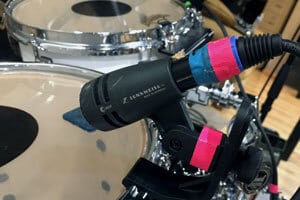
Close miking refers to microphones that are placed close to an instrument or sound source. For example,
Other close mic examples include use on tom drums, vocal mics, guitar cabinets, on a variety of wind and brass instruments, and really any other situation where you can think of mounting a microphone close to a sound source.
Typically, the microphone is placed no more than 12 inches in distance away.
Close Miking is Beneficial for Two Main Purposes:
- Isolates the microphone signal from noise in the room
- Isolates the microphone signal from other instruments around it
As you can imagine, a drum set is very loud and there are a lot of instruments in extreme proximity to one another.
The SM57 is often used as a snare drum microphone, as it rejects noise very well from the
Distant miking is the practice of recording a sound source from a distance away.
This technique is generally used to capture the stereo image of a drum kit when in a studio, but can also be used to record an orchestra, an audience for a live recording of a concert, or even just an acoustic guitar in a room.
The Microphones you Pick Matter – Building Your Own Drum Mic Kit
If you’re just starting out, I suggest you stick to these and only these. The more microphones you add, the more problems you’re going to have.
Things like phase, comb filtering, and the number of available inputs become a major issue.
- Kick microphone (my suggestion: Shure Beta 52A or AKG D112)
- Snare microphone (my suggestion: Shure SM57)
- Tom microphones (my suggestion: Sennheiser MD 421-II)
- Overhead microphones (my suggestion: Warm Audio WA-84 pair)
Do I Need Overhead Microphones for Recording Drums at Home?
You don’t necessarily have to have overheads, but I strongly suggest doing so. If you want your demos for your band or your YouTube videos to have a professional sound, overhead microphones help them get there.
If you’re only using close mics, your cymbals will be left out of the mix and you won’t be happy with the end result.
First off, you’re not just capturing the cymbals when you use overheads (though you can do that), you’re capturing the entire stereo image of the drum kit. I recommend using the spaced pair stereo technique when first adding overheads to your setup.
Now, there are other techniques (XY, recorder man, etc), but I really suggest focusing on
But, Big Studios Don’t Use Mic Kits
While a drum microphone kit will get you everything you need to get going, mic wise, most professional recording studios don’t rely on pre-packaged kits when selecting microphones.
The mic lockers you’ll find have a large variety of different brands and manufacturers.
If you’re just learning how to shoot drum covers for YouTube, a drum mic kit is a perfect entry into microphones and the recording world.
Let’s say you buy the Shure DMK57 mic kit. You’ve got everything you need to get close-miked drums.
While you will be able to use these microphones for the rest of your career (these are all standards used all the time), you potentially will need to get some overhead microphones.
Other packs I have discussed in our list do include overheads, but I think you’ll find that over time, you’ll want to buy the overheads separately.
Drum Mic Kits for Live Sound
Live sound is much different than that of recording in a professional studio.
These microphones require a lot more durability since they are prone to being dropped, lost, knocked around in a trailer, and other ways we can think of mishandling them.
In general, unless you’re in some major arena rock band, it’s a good idea to spend no more than $200 per individual microphone you’ll be touring with.
The e604 by Sennheiser is a perfect touring microphone. For starters, they sell these in packs of three. You’ll want to have a lot of these mics, as they are extremely versatile.
They can clip on to almost any drum rim. I’ve toured enough to know that these microphones are “the go-to” live tom microphone, and even some use it on snare drums. The e604 is also included in Sennheiser’s e600 mic package.
What Do You Mean, Kick In and Kick Out?
As you enter the live world, you’ll soon start to realize that most engineers tend to use two different microphones on the bass drum: kick in and kick out.
The kick in microphone tends to be a condenser boundary microphone, like the Beta 91a.
This mic, while a little thinner in the low end, provides a crisp attack and “clickier” sound than that of a dynamic microphone. I personally use and love the Beta 91a. There’s a fantastic company, Kelly SHU, who makes an internal mounting system for this microphone.
My kick in mic literally stays inside my bass drum all the time and I haven’t had to pull it out once since installing the Kelly SHU. The kick out microphone is the one we’re most familiar with. A common kick out microphone is the Beta 52 from Shure.
This type of dynamic microphone captures a lot of the woof and low end a kick drum produces and less of the attack. These two microphone signals are combined and processed to get a massive kick drum sound you hear at most rock shows.
The Overheads Translate the Entire Image of the Drum Set
You might be thinking, “hey, I’ve got my snare, toms, and kick miked up, what else could I need?”
The overhead microphones change the game when it comes to an in-ear monitor mix.
Not only do you hear your cymbals, but you hear the entire kit with a beautiful sheen of high end (depending on the mics, of course).
In small clubs and venues, you really don’t need overhead microphones, and the sound engineer will even advise against it.
However, if you do have in ears and want to use them, I highly suggest doing so. Playing only close-miked drums is so one-dimensional. It’s hard to get into.
The sound engineer won’t be sending the overhead channels to the PA and that’s okay. If it’s worth it to you, set up those addition microphone stands and cables.
Do I Need a Hi-hat Microphone and Snare Bottom Mic When Playing Live?
Unless you’re playing clubs to 300+ people every night, I personally believe you do not need a hi-hat or snare bottom microphone.
If your sound engineer likes to use them even in small rooms, then go for it.
The majority of sound engineers hate hi-hats and, in fact, I don’t even use one unless I’m told they wanna add one.
I always joke around with sound engineers about adding more hi-hat to the mix. No one ever wants more hi-hat in a live mix.
Many sound engineers do like to use snare bottom microphones, but I don’t think you’ll need one at first.
Chances are if they want to use one, they’ll have a spare SM57 they can just pop under your snare for that gig.
Using a Crowd Microphone for Added Ambience
If you use in-ear monitors, you need to know about crowd mics.
Pointing at the audience, crowd microphones pick up the room sound in either stereo or mono, depending on your current setup.
Your live mix can sometimes lack a sense of space (even with artificial reverb). Crowd mics change the game when it comes to your in-ear mix.
I find that
You Might Not Need a Drum Mic Kit, Yet
Not all drummers need drum microphones right away. If you play in a band and just play local shows around town, you probably don’t need them yet.
Your local club more than likely has microphones ready to go for shows, so you just need to bring your drums.
Cheap Knockoff Microphones in Disguise
I also will advise staying away from the cheapest microphone packs, as you really get what you pay for when it comes to microphones and live sound.
Pyle Pro makes a very inexpensive SM58 clone that sounds like absolute garbage. I cannot ever recommend someone going this route unless you are extremely desperate.
The microphone itself looks identical to its Shure counterpart, but sounds very thin and will clip easily as you give it more gain.
Protecting Your Microphones
The nice part about buying a drum microphone kit is that most of them will come with a protective case for transportation. In my experience however, these cases are usually pretty terrible.
Most engineers these days use hard cases, like a Pelican, to keep their microphones safe. These cases can be awfully expensive, so be sure to read our roundup post on the best Pelican case alternatives.
If you’re in a situation where it makes absolute sense to buy a mic kit, such as using an in-ear monitor system, then you’re going to want to bring your own microphones to gigs.
Be sure to let the club and sound engineer know ahead of time, before the day of the show, what your band will be bringing so they don’t set up a bunch of unneeded stands and microphones.
Conclusion
Well, we have finally come to the end of our list. From budget-friendly packages to industry staples – we have certainly exhausted all the options for selecting the best drum mic kit for your needs.
After all, having a great setup is essential for capturing that perfect take when recording drums. Keeping in mind things like the type of mic, number of mics included, and other specs can help you narrow down which mic kits will bring out your full potential behind the kit!
Finally, we would love to hear what you chose for yourself and if we missed any must-haves worth mentioning. Be sure to leave a comment below so we can keep this list up-to-date and relevant with feedback from folks like you! Which drum microphone kit did you end up going with? Did we miss anything? Let us know how you made out – we are here and ready to hear the results!




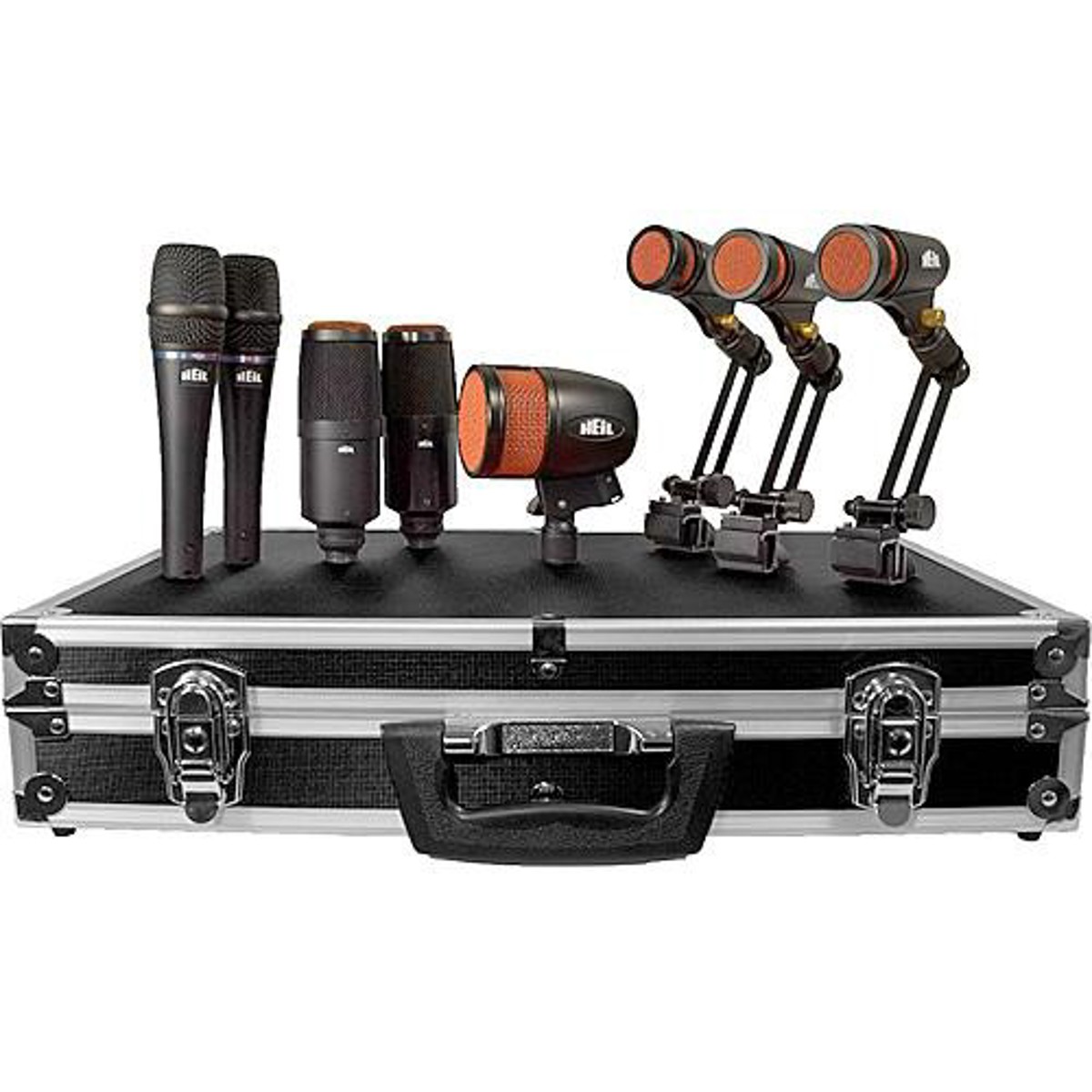

 Amazon.com
Amazon.com 
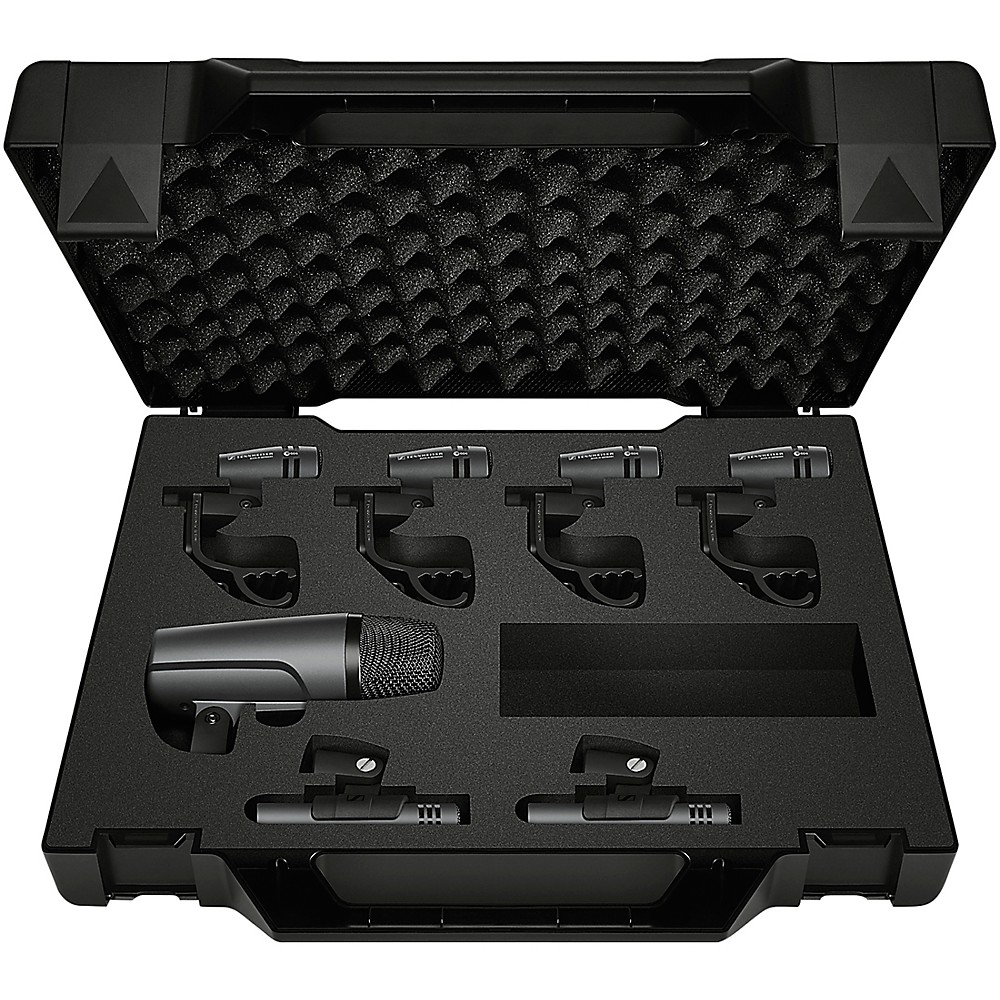

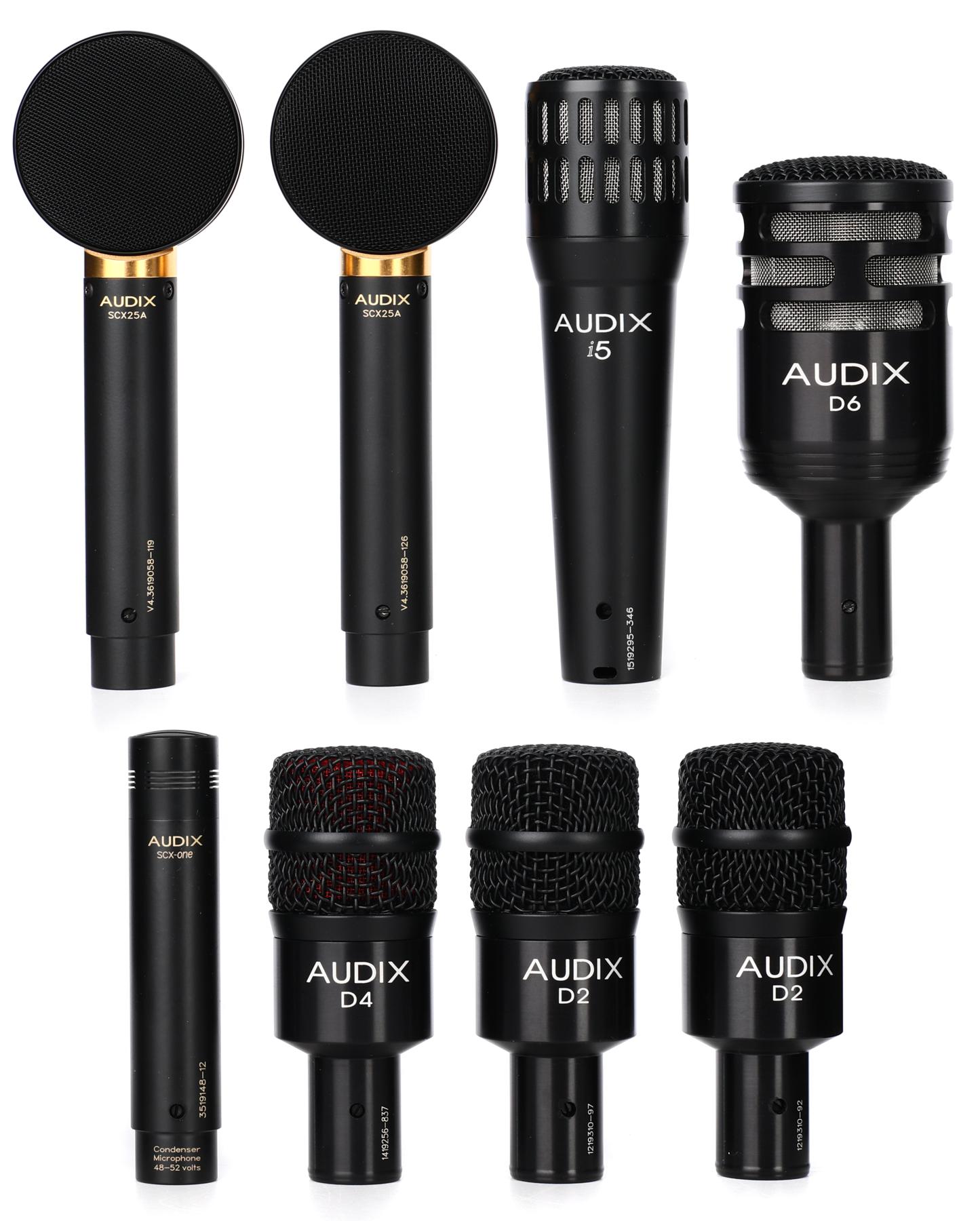


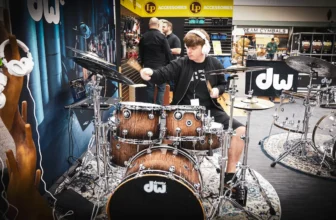
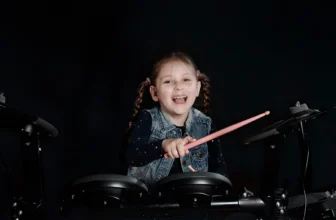
Nick,
Great post – thank you!
Have you listened to the recently-released Presonus DM-7 kit by chance? They good solid reviews in Sound-on-Sound but I was very interested to get your take. Quite affordable at $300 for the kit.
Thanks!!
Nick, your knowledge and expertise on drumming and recording equipment is well appreciated. Now retired, but always a Ludwig & Shure equipment fan. Good to know that there are older pa & mic (Shure, Audix) companies that have continually improved there product line by upgrading and staying competitive in the 21st Century. I thank you for all your tips. Including moving blankets for basement acoustics. I will work on head technology later (Using Fiber-Skins by Remo since 90’s😎).
Nick, Keep up the good work in sharing and keeping us informed. Playing around Lansing MI, email me and let me know.